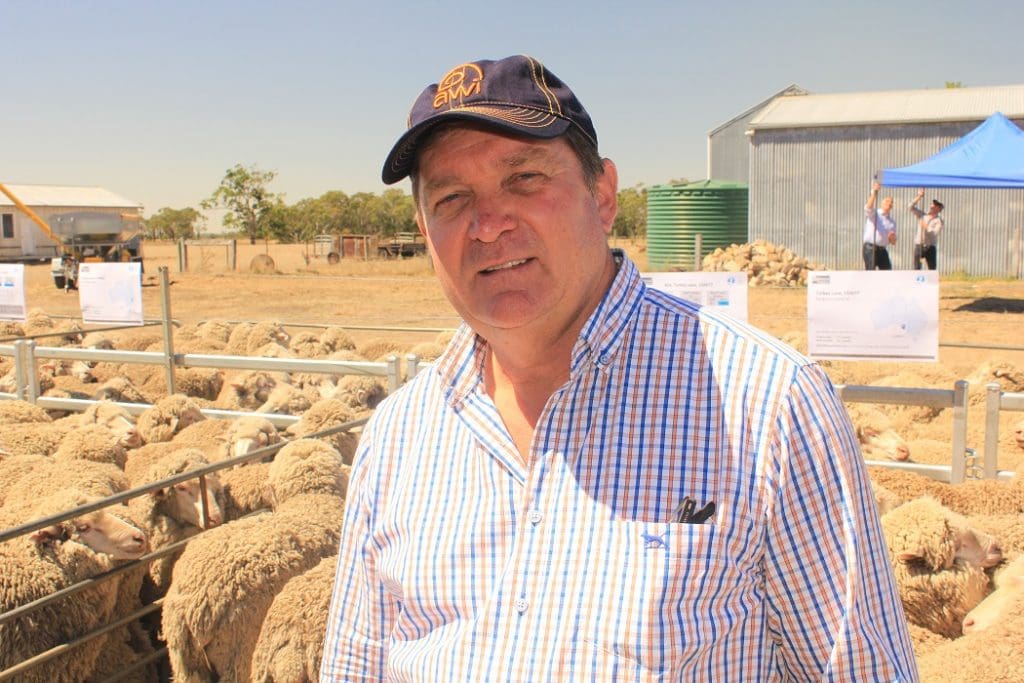
NSW broker and grower, AWI director Don Macdonald.
AUSTRALIA’S sheep industry needs to utilise all levy reserve and collaboration options to alleviate the shearer shortage and wool harvesting crisis, according to New South Wales broker Don Macdonald.
Mr Macdonald is also an Australian Wool Innovation director and said the Australian wool industry is facing a wool harvesting crisis “like never before.”
“It is a labour and a skill shortage crisis and the shearing is right at the pointy end of it.”
State and international border closures have exacerbated the shearer shortage recently, and producers have managed to produce a second year of positive lamb marking figures,” he said.
“The shearing contractors are at their wits’ end, and there are contractors who are saying this all too hard, I’ll go back on the stand and just shear.
“It’s a critical problem.”
Mr Macdonald said there has been an increase in exclusion fencing in Queensland, with the help of government and AWI resources, to exclude wild dogs and enable people to re-enter the sheep industry.
“And guess what, they are now finding there are no contractors up there, they can’t get their sheep shorn.
“So whether it is goats, Dorpers or cattle, take your pick, we (the wool industry) is really under threat,” he said.
As a broker, Mr Macdonald said he had significant clients concerned about being stood over by a minority of shearers demanding higher rates for shearing due to the shearer shortage.
“People feel like they are being held to ransom.
“I’m starting to see a bit of animosity creep back into the relationship (between shearers and growers).”
Mr Macdonald said the current crisis is why AWI has levy reserves.
“This where we have to use those reserves to try and fix this problem.
“We can do all the fancy marketing, and research and development in all sorts of areas down the pipeline, but it ain’t worth a crumpet if we can’t get the wool off their back,” he said.
But Mr Macdonald said all sheep industry levy sources and their funded bodies – including MLA and Animal Health Australia — needed to be involved, because of the issue’s ramifications for wool and meat, and for animal welfare.
“Wherever levies are paid by growers are fair game for this.”
Mr Macdonald said the latest Meat & Livestock Australia/AWI survey showed there is a trend away from wool sheep.
“That trend is just going to accelerate if we can’t get sheep shorn.
“I’ve got a big client who shears 70,000-90,000 sheep and he said ‘we would do all our shearing in 3-4 months of the year and I really used to look forward to it’.
”Now with an eight-stand shed with three shearers working and it is dragging on into five months, and the fun has gone out of it,” he said.
“He has a property in the Riverina that was down to two shearers and the wool classer had to get on and do a few (sheep).”
Mr Macdonald said the contractors are being forced to drop clients with the tough-shearing sheep, those with crutching jobs or the “slow payers.”
He said the shearer shortage, compounded by the COVID pandemic and flystrike issues, would drive people out of wool production faster than any other issue the industry was facing.
“It’s happening.”
Mr Macdonald said the industry needed to look at a number of measures, including labour and visa scheme to bring in overseas workers and more training.
“But these are short-term measures, until we find something else – that’s what we have to go looking at.
“That’s why we have those significant (AWI) reserves – to find that silver bullet that makes a tangible difference to wool growers being able to get their wool harvested,” he said.
This could be options like revisiting chemical defleecing, Mr Macdonald said.
“We’ve got to do something and surely with the level of reserves we have, this is the time to put the money on the table.”
He said the industry had to have a mindset of ‘we have to do this’ rather than focus on the barriers.
“We need to go to whoever we have to partner with, it could be DFAT or your local members.
“This is not going to be solved by one group within the industry; it has to be solved by the industry using all the help it can get, whether it is National Farmers Federation, the government of the day, Department of Foreign Affairs and Trade, they all have to come together on this one.”
Shearing contractors support levy funds action
Industry is in a ‘state of emergency’ – Woods

NCWSBA president Rowan Woods.
National Council Wool Selling Brokers president Rowan Woods agreed that the industry was facing “a total disaster” with flystrike issues now adding to the lack of shearers.
“It is state of emergency, it is so hard to procure shearing teams.
“There are guys on the Monaro who have been waiting for shearers since November and they have been through this wettest Summer on record trying to keep flies out of sheep,” she said.
“It doesn’t augur well for keeping people in the game.”
He said there reports of shearer shortages in every state, with shearing contractors unable to get sufficient workers.
Mr Woods said crossbred flocks have been some of the worst-affected by flystrike this Summer, with shorn crossbred sheep getting struck on the shoulder.
“No-one is immune from this, these are troubling times.”
Mr Woods said the recent wave of Omicron COVID infections has compounded the shearer shortage.
“It is a shortage of humans, there are just not enough shearers to shear the sheep.”

The agents are making triple on cattle commission to what they were, but the shearers are standing over the tough shearing sheep? Mr Macdonald’s clients obviously have big heavy cutting sheep and want to pay the same rate as a 30 kg crossbred lamb. The good shearing sheep are getting done. Quite a few young people are coming into the industry around our area, but it’s not station country. As for the platforms, can a shearer make a grand a day? I have a Tepari sheep handler and it takes the drag out of crutching. Harry, I call it — a great bloke.
I totally agree with Don Macdonald. Look no further than the example set by Grant Burbidge.
There is good money available for shearing, we just need to make it easier for all concerned, otherwise we’ll struggle to maintain our industry.
As an outsider passionate about the wool supply chain, I wanted to know how the wool industry could grow through innovation. What I quickly learnt were the consequences of not shearing the sheep at the right time and that it is critical to the quality and characteristics of the fleece and the wellbeing of the animal. New tools have helped make shearing easier and less arduous work; however, the challenge remains that there is a shortage of local skilled shearing, classers and wool handlers, and they are expensive…this is all before the pandemic. Labour on the farm, especially shearing, is challenged because of the lack of a skilled local workforce or young generations not entering the industry. Faced with a physically demanding job, away from family and friends, shearing has attractive pay, but the lack of consistency and harsh conditions make stable city jobs more appealing. Outsourcing labour puts pressure on the farm from an economic perspective. It has to incentivise people to keep coming back season after season.
Having technologies on the farm such as good internet service and comfortable living conditions can incentivize workers, but it’s all hidden costs that (my fashion industry) do not see.
The industry has to look for alternatives where labour shortage is a critical factor. Taking advantage of Australia’s standard pay rate, foreign workers can make a lot of money and more women are coming into the industry. The acceptance of women taking positions in the wool sheds has benefits to the product because where they lack physical strength, they make up for it with a good touch. There is simply not enough innovation that is successfully improving the hard work shearers and their teams have to endure. There are efforts in robotic shearing that mimic body movements, improve quality control, performance predictability and ensure workers safety, however; this is still in the early stages and needs collaborative support.
Farmers know they can breed a better sheep; a finer, cleaner, superior fibre, yet nearly no headway to innovate the process that has been the same way for centuries. The problem is the limited resources as well as the critical timing for shearing. The fact that they play such importance to the quality of the fleece supports the need for innovation. This is an area that has not had much attention and is relying on outsourcing which is a high risk for expertise as the industry moves into the next generation. Perhaps giving local shearers a better pay rate than foreigners, or a tax break, or free training with apprentices to attract younger people to the industry? It would be of interest to diversify the board at AWI, to make sure they have shearers who would know how the animal behaves and how to handle them during shearing, as well as when the best timing is. They could offer fantastic advice and experience for how to innovate woolshed activities.
Promote the trade to local youth and show them they can be involved in flying drones and robots and the latest science whilst working alongside nature and helping to reduce the impact of climate change.
At last we have someone in AWI who is close to the coal face. Furthermore, he is pushing to put levy funds to save the wool industry. Too many wool growers are in denial of the major issue facing the wool industry. Imagine if we had more sheep…
This is not a new problem. It has been developing for decades.
Part of the solution has already been developed. We have shorn 175,000 sheep on our wool harvesting platform system. We are training people who have no prior experience in the wool industry and would never take up conventional shearing because it is too hard.
Our system could be shearing half the sheep in Australia in five years time if there was the right training program.
We keep developing this system. The latest is adjustable cradles to suit sheep of any size.
In the six years we have been using this system, not one person from AWI has been to have a look at it in operation. We welcome anyone who wants to have a look.
https://www.burbidgefarms.com/wool-harvesting
Congratulations on your shearing innovation Grant. I often direct people to https://www.burbidgefarms.com/wool-harvesting when they complain about their shearing issues or are wondering about investing in a new shed. Often with technology adoption, timing is key. Why change if we don’t have too? I hope the timing is now good for your solution to get some airtime.
I cannot believe that no one from AWI has checked out the platform shearing system you have been using now for several years. You have self-funded this system and tried to promote its benefits for years but no one wants to take the time to check it out.
Congratulations Don, for highlighting what is now the biggest issue in the wool industry. Our absolute priority must be encourage and train young people to take up shearing. We need innovation to assist the easier handling of sheep which are getting heavier. Graziers also need to improve the the safety and amenities within shearing sheds if we want to entice young people into the industry.
I fully support Mr Macdonald’s comments. Instead of luxury overseas event promotions, train up young Aussies. Most are totally unaware of the opportunities shearing can offer: great pay, well-respected industry, travel opportunities, changing work environment and great camaraderie.